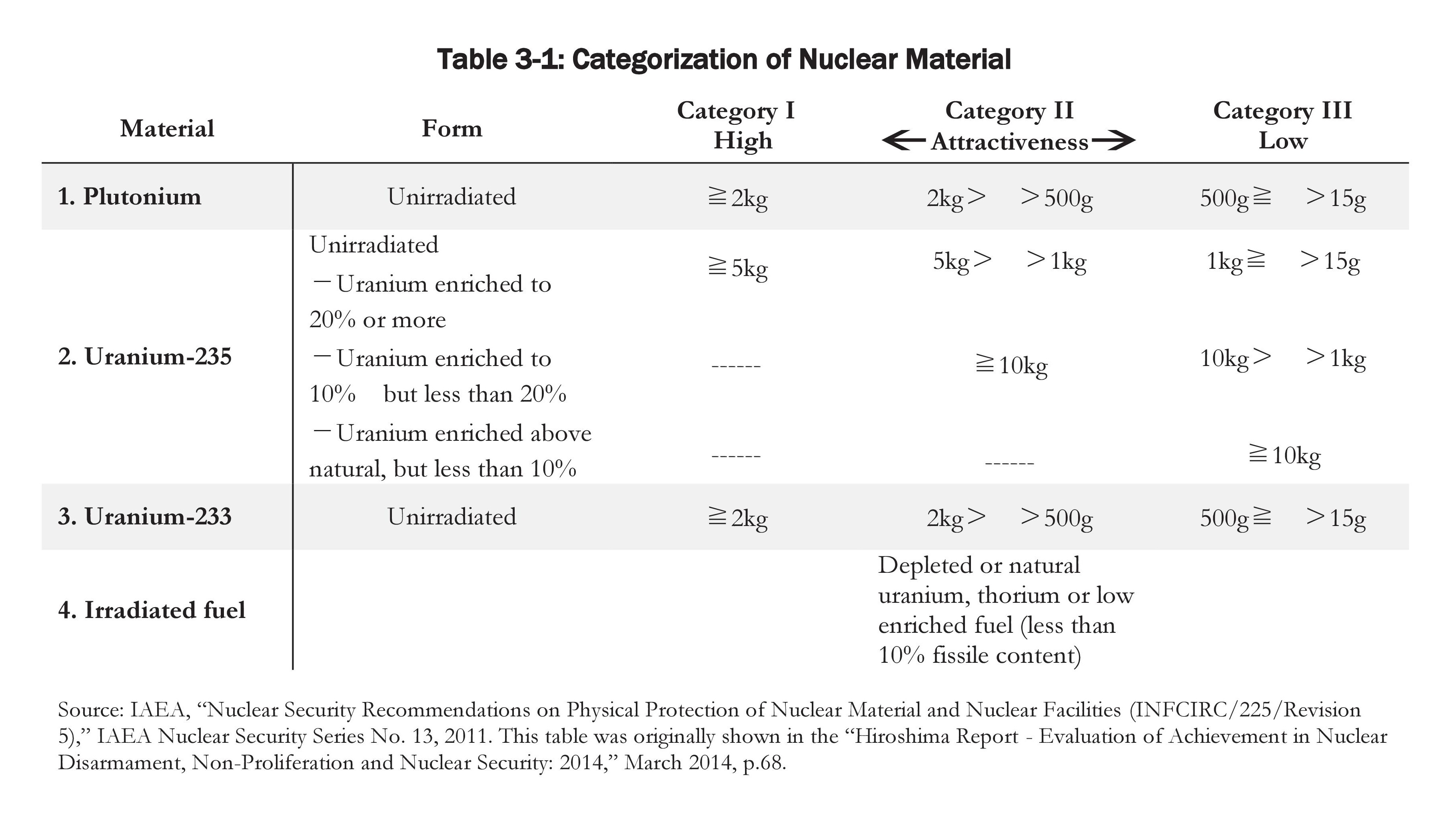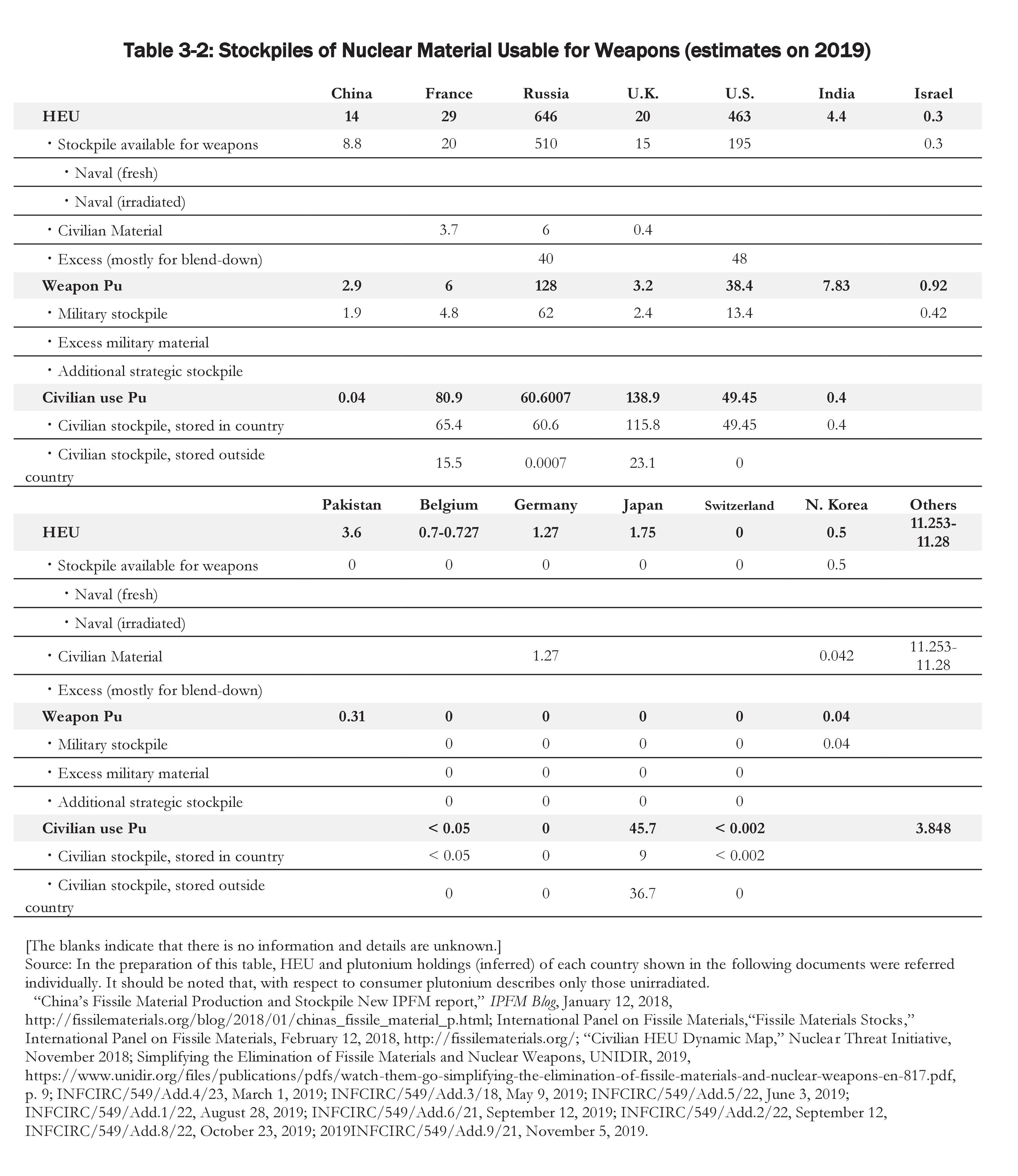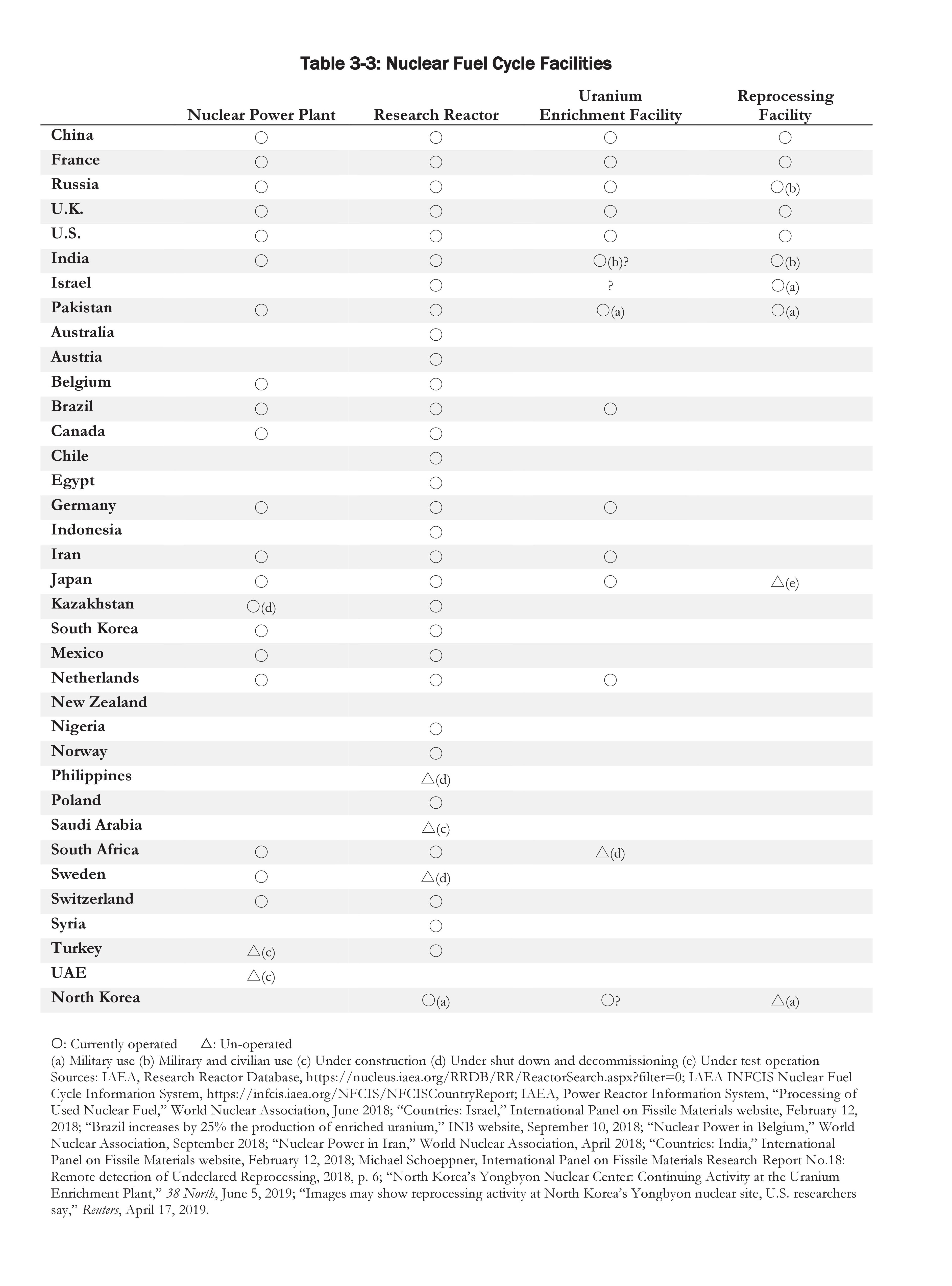(1) Physical Protection of Nuclear Materials and Facilities
(1) Physical Protection of Nuclear Materials and Facilities
According to the IAEA definition, a nuclear security is “the prevention of, detection of, and response to, criminal or intentional unauthorized acts involving or directed at nuclear material, other radioactive material, associated facilities, or associated activities.”29 Nuclear security threats indicates “a person or group of persons with motivation, intention and capability to commit criminal or intentional unauthorized acts involving or directed at nuclear material, other radioactive material, associated facilities or associated activities or other acts determined by the state to have an adverse impact on nuclear security.”30 The IAEA recommends that the state’s physical protection requirements for nuclear material and nuclear facilities should be based on a Design Basis Threat (DBT), specifically for unauthorized removal of Category I nuclear material, sabotage of nuclear material and nuclear facilities that have potentially high radiological consequences.31 Furthermore, the IAEA recommended that security requirements for radioactive material “should be adopted depending on whether the radioactive material concerned is sealed source, unsealed source, disused sealed source or waste, and should cover transport.”32
The latest version of the IAEA’s “Nuclear Security Recommendations on Physical Protection of Nuclear Material and Nuclear Facilities” (INFCIRC/225/Rev.5) was revised and published in 2011. In this revised edition, the IAEA recommends that requirements for physical protection should be based on a graded approach, taking into account the current evaluation of the threat, the relative attractiveness, the nature of the nuclear material and potential consequences associated with the unauthorized removal of nuclear material and with the sabotage against nuclear material or nuclear facilities.33 The IAEA also suggests that “the physical protection system should be designed to deny unauthorized access of persons or equipment to the targets, minimize opportunity of insiders, and protect the targets against possible standoff attacks consistent with the state’s threat assessment or design basis threat.”34 In other words, the system should protect against attacks that are executed at a distance from the target nuclear facility or transport and that do not require that the adversary have hands-on-access to the target, nor require the adversary to overcome a physical protection system.
The objectives of the state’s physical protection regime, which is an essential component of the state’s nuclear security regime, should be to protect against unauthorized removal, to locate and recover missing nuclear material, protect against sabotage, and mitigate or minimize effects of sabotage.35 As of January 2020, there are 442 reactors operating worldwide, 53 under construction, 110 being planned, and 330 proposed to be built.36
The nuclear material itself is the primary factor for determining the physical protection measures against unauthorized removal. Therefore, categorization based on the different types of nuclear material in terms of element, isotope, quantity and irradiation is the basis for a graded approach for protection against unauthorized removal of “attractive” nuclear material that could be used in a nuclear explosive device, which itself depends on the type of nuclear material, isotopic composition, physical and chemical form, degree of dilution, radiation level, and quantity (see Table 3- 1).37

Generally, weapon-grade fissile material can be very attractive to terrorists who are looking to produce nuclear weapons. Therefore, these nuclear materials require high-level protection measures. In assessing the importance of preventing illicit transfers and sabotage, even if countries do not possess weapons-grade HEU or plutonium, they are at risk if they possess a uranium enrichment facility or a nuclear reactor and a plutonium reprocessing facility. The number of such sensitive facilities in a country will be the subject of assessment for a state’s effort in enhancing nuclear security. Of course, the level of these protection measures will vary depending on the geopolitical circumstance or the domestic security situation. According to various publications, the amount of weapons-grade fissile material held by the countries surveyed in this report is shown in Table 3-2.
While the global stockpile of HEU and separated plutonium has occupied the attention of the international community and civil society, there is little officially disclosed information about stockpiles of HEU and weapon-grade plutonium by individual states, due to the sensitivity of these materials.
Against the above background, although not specifically described in Table 3-2, the following cases are estimated for the possession of certain fissile materials (as of October 2019):38
➢ Countries assumed to retain approximately 1 ton of HEU (category I is 5 kg and more): Kazakhstan (10,427-10,777kg*), Canada (1,038kg)
➢ Countries assumed to retain 1 kg or more, but less than 1 ton, of HEU: Australia (2 kg), Iran (6 kg (radiated)), the Netherlands (550-650kg), Norway (1-9 kg), South Africa (700-750 kg (unspecified))
➢ Countries assumed to retain less than 1 kg of HEU:Syria (less than 1 kg)*: Updated figures in 2019.
As a result of activities of the recent Global Threat Reduction Initiative (GTRI), the number of countries that completely removed HEU has increased in recent years. Argentina, Austria, Brazil, Bulgaria, Chile, Columbia, Czech Republic, Denmark, Georgia, Ghana, Greece, Hungary, Indonesia, Iraq, Jamaica, South Korea, Latvia, Libya, Mexico, Nigeria, the Philippines, Poland, Portugal, Romania, Serbia, Slovenia, Spain, Sweden, Switzerland, Thailand, Turkey, Ukraine, Uzbekistan, Vietnam, etc. are cited as countries that achieved complete removal of such HEU.39

For reference information, estimated holdings of HEU and plutonium of some countries not in the list of this survey are as follows:
➢ Countries assumed to retain 1 kg or more, but less than 1 ton, of HEU: Belarus (80-280 kg), Italy (100-119kg)40
Any operating reactor or facility for handling spent fuel presents a potential risk of illicit transfer of fissile material or sabotage against the facility. In particular, research reactors can pose a greater risk if they utilize HEU fuel and if they are associated with spent-fuel reprocessing facilities or even unsecured storage of spent fuel. Therefore, the possession of “highly attractive” facilities in the surveyed countries may also have a corresponding impact on nuclear security risks.
The IAEA’s Research Reactor Database (RRDB)41 shows that 223 out of a total of 857 research reactors are currently in operation (136 in developed countries, 87 in developing countries). Another 14 reactors (10 in developed countries, four in developing countries) are temporarily shut down; nine reactors (four in developed countries, five in developing countries) are under construction; 14 reactors (two in developed countries, 12 in developing countries) are scheduled for construction; 13 reactors (five in developed countries, eight in developing countries) are extended their shutdown; 58 reactors (44 in developed countries, 14 in developing countries) have been permanently shut down; 443 reactors (413 in developed countries, 30 in developing countries) are decommissioned; 67 reactors (63 in developed countries, four in developing countries) are under decommissioning; and construction of 16 reactors (12 in developed countries, four in developing countries) have been canceled. Although there was no increase or decrease in the number of research reactors compared to the previous year, the number of reactors in operation decreased by four and the number of temporarily suspended reactors increased by two. In addition, two research reactors in the state of permanently shut down increased.
According to the IAEA, 20,663 spent fuel assemblies from research reactors are enriched to levels above 20% and 9,532 of these stored fuel assemblies are enriched to levels at or above 90%.42
The figures for these spent fuel assemblies have not changed at all since last year, as seen below. Incidentally, the second largest fuel assemblies with regard to the concentration of HEU are those with concentrations of 40% or less, which number 7,485 bodies. In terms of geographical distribution, 10,627 spent HEU fuel assemblies, which are over half of the total, are currently stored in Eastern Europe, 572 are located in Africa and Middle East, 3,492 in Asia, 4,273 in Western Europe, 85 in Latin America and 1,614 in North America.43 As mentioned above, the regional distribution of spent fuel assemblies is still primarily centered in Eastern European regions. Given this situation, prevention of illegal transfers and sabotage against facilities becomes critically important as a measure against nuclear security risks, regardless of whether or not a given reactor is in operation.
Table 3-3 outlines the presence of nuclear power plants, research reactors, uranium enrichment and reprocessing facilities in surveyed countries, as risk indicators. Among these, uranium enrichment and reprocessing facilities, in particular, are sensitive to nuclear security.
The IAEA recommends that a state define the risk based on the amount, forms, composition, mobility, and accessibility of nuclear and other radioactive material, and take prospective measures against the defined risk. In terms of unauthorized removal, nuclear or other radioactive material and related production facilities are also potential targets.44 To reduce the potential for sabotage within a plant, the IAEA recommends that a state “establishes its threshold(s) of unacceptable radiological consequences” and identifies the vital areas where risk-associated materials, devices, and functions are located and designated “in order to determine appropriate levels of physical protection taking into account existing nuclear safety and radiation protection.”45
In recent years, efforts are also being made regarding nuclear security of radioactive sources. In this field, the IAEA has published “Nuclear Security Series No.11, Security of Radioactive Sources (2009)”46 and “Nuclear Security Series No.14, Nuclear Security Recommendations on Radioactive Material and Associated Facilities (2011).”47

Also, at the Washington Nuclear Security Summit in 2016, 28 countries and INTERPOL jointly released a “Gift Basket” statement on strengthening the security of high-activity sealed radioactive sources, reflecting the IAEA’s Code of Conduct on the Safety and Security of Radioactive Sources.48 In addition, in 2018, IAEA published the Guidance on the Management of Radioactive Sources.49
An example of these multilateral initiatives in 2019 was a pilot training course on the security of radioactive materials for Eastern Europe and Central Asia in January.50 In addition, a multiregional project meeting on sustainable management for disused sealed radioactive sources (DSRS) was held in Vienna in April. The project was intended to support 11 countries in South America, Africa and the Pacific, and working plans for long-term DSRS management cooperation were examined by regulators and storage facility operators in participating countries.51
Also in April, the eighth annual meeting of the Working Group on Radioactive Source Security was held in Vienna.52 In May, the IAEA Regional Practice Course in the first two languages of English and Russian was held at the Russian Rosatom Technical Academy with the participation of 24 companies and regulators from various countries dealing with radioactive materials.53 Also in May, the review meeting of the “Code of Conduct on the Safety and Security of Radioactive Sources: Guidance on the Import and Export of Radioactive Sources (*published in 2005 by the IAEA)”54 was held in Vienna, attracting more than 190 experts from 103 countries. Although 137 countries have already shown political involvement, the IAEA’s code of conduct is not legally binding.
Therefore, it is evaluated that such review meetings provide valuable opportunities for progress reports on the implementation of the Code of Conduct, the exchange of lessons, and discussions of improvement measures.55
29 IAEA Nuclear Security Series Glossary Version 1.3 (November 2015) Updated, p. 18.
30 Ibid., p. 28.
31 INFCIRC/225/Revision 5, p. 13.
32 IAEA, “Nuclear Security Series No.14 Nuclear Security Recommendations on Radioactive Material and Associated Facilities,” 2011, p. 14.
33 INFCIRC/225/Rev.5, paragraph 3.37.
34 Ibid., paragraph 5.14.
35 Ibid., paragraph 2.1.
36 “World Nuclear Power Reactors & Uranium Requirements,” World Nuclear Association, January 2020, https://www.world-nuclear.org/information-library/facts-and-figures/world-nuclear-power-reactorsand- uranium-requireme.aspx.
37 IAEA, “Nuclear Security Series No.13 Nuclear Security Recommendations on Physical Protection of Nuclear Material and Nuclear Facilities (INFCIRC/225/Rev.5),” 2011, paragraph 4.5.
38 “Civilian HEU: Who Has What?” Nuclear Threat Initiative, October 2019, https://media.nti.org/ documents/heu_who_has_what.pdf; “Civilian HEU Dynamic Map,” Nuclear Threat Initiative, November 2018, https://gmap.nti.org/other_maps/heu/index.html.
39 Ibid.; Chuck Messick, et.al., “Global Threat Reduction Initiative: U.S.-Origin Nuclear Fuel Removals,” U.S. Department of Energy, https://www.energy.gov/sites/prod/files/em/GlobalThreatReduction Initiative.pdf.
40 Ibid.
41 IAEA, “Research Reactor Data Base,” https://nucleus.iaea.org/RRDB/RR/ReactorSearch.aspx?rf=1.
42 IAEA, “Worldwide HEU and LEU Assemblies by Enrichment,” https://nucleus.iaea.org/RRDB/ Reports/Container.aspx?Id=C2.
43 IAEA, “Regionwise distribution of HEU and LEU,” https://nucleus.iaea.org/RRDB/Reports/ Container.aspx?Id=C1.
44 IAEA, “Nuclear Security Series No. 14.”
45 Ibid., p.14.
46 IAEA, “Nuclear Security Series No. 11 Security of Radioactive Sources,” 2009.
47 IAEA, “Nuclear Security Series No. 14.”
48 “Joint Statement Strengthening the Security of High Activity Sealed Radioactive Sources (HASS),” 2016 Washington Nuclear Security Summit, March 11, 2016.
49 IAEA, “Guidance on the Management of Disused Radioactive Sources 2018 Edition.”
50 “Pilot Course Based on New Guidance Helps to Increase Security of Radioactive Material in Eastern Europe and Central Asia,” IAEA, January 4, 2019, https://www.iaea.org/newscenter/news/pilot-coursebased- on-new-guidance-helps-to-increase-security-of-radioactive-material-in-eastern-europe-and-centralasia.
51 “IAEA Kicks Off Multi-Regional Project on Sustainable Management of Disused Sealed Radioactive Sources,” IAEA, June 14, 2019, https://www.iaea.org/newscenter/news/iaea-kicks-off-multi-regionalproject- on-sustainable-management-of-disused-sealed-radioactive-sources.
52 “Looking for More: IAEA and National Experts Discuss Security of Radioactive Sources,” IAEA, April 29, 2019, https://www.iaea.org/newscenter/news/looking-for-more-iaea-and-national-experts-discusssecurity- of-radioactive-sources.
53 “First Bilingual Regional Course on Security of Radioactive Material Held in Russia,” IAEA, June 14, 2019, https://www.iaea.org/newscenter/news/first-bilingual-regional-course-on-security-of-radioactivematerial- held-in-russia.
54 IAEA, “Guidance on the Import and Export of Radioactive Sources.”
55 “Wider Implementation of IAEA Code of Conduct to Enhance Safety and Security: Review Meeting Concludes,” IAEA, June 11, 2019, https://www.iaea.org/newscenter/news/wider-implementation-ofiaea- code-of-conduct-to-enhance-safety-and-security-review-meeting-concludes.







